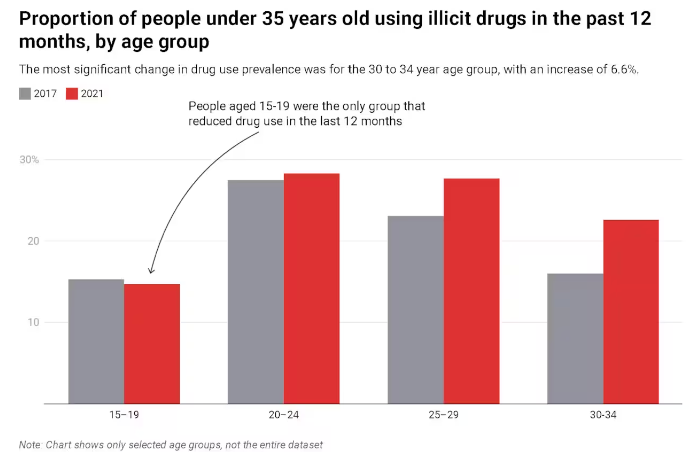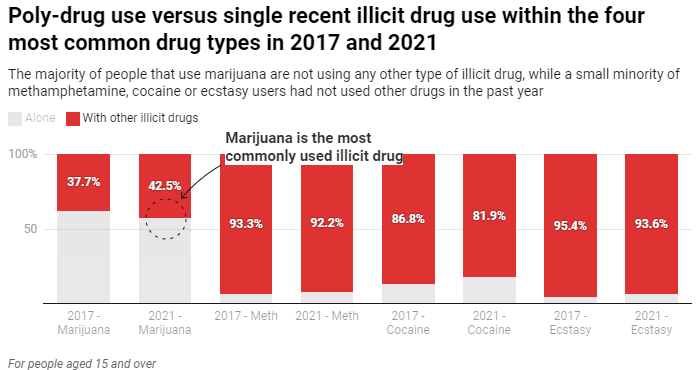Australia is taking more drugs, smoking less and still binge drinking: A tale in seven charts

The Household, Income and Labour Dynamics in Australia (HILDA) survey, tracking 17,000 Australians annually, reveals significant trends in smoking, vaping, binge drinking, and illicit drug use. Smoking rates have declined from 2001 to 2021, with male smokers dropping from 25% to 16% and female smokers from 20% to 12%, reflecting the success of tobacco control measures. Conversely, vaping has emerged as a prevalent activity, especially among young adults, with 14.1% of those aged 15 and over having experimented with it. Binge drinking persists, particularly among young men, although risky drinking patterns have slightly decreased since 2009. Illicit drug use has increased across both genders, particularly among individuals aged 30 to 34, with polydrug use common among users of methamphetamine, cocaine, and ecstasy. These findings highlight shifting patterns in substance use and the evolving challenges in public health and policy.
Australians’ vices, including drinking, smoking and illicit drugs, have been revealed in the latest HILDA survey.
The Household, Income and Labour Dynamics in Australia survey tracks the same 17,000 Australians each year, with participants followed over the course of their lifetime. The survey collects information on many facets of life and is the only study of its kind in Australia.
Smoking is declining, but young people are more likely to vape
There has been substantial progress in reducing smoking rates since 2001, when 25 per cent of males and 20 per cent of females aged 15 and over reported being smokers. In 2021, these rates had dropped to 16 per cent for males and 12 per cent for females.
This likely reflects the effects of tobacco control measures, as well as increased public awareness of the harmful health effects of smoking.
Declines have been biggest for young people, which reflects the fact that it is easier to prevent the take-up of smoking than it is to get smokers to quit. Indeed, HILDA shows that over 60 per cent of people who quit smoking take it up again within three years.
Smoking rates in Australia are falling
People aged 15 years and over, 2003 to 2021
The progress on reducing smoking appears to have been somewhat offset by the rise in vaping or using e-cigarettes. In 2021, 14.1 per cent of people aged 15 and over reported having tried vaping, and 16 per cent of these people vaped daily.
Vaping is very much a young person’s activity. It is most common among people aged 15 to 24, and also relatively common among people aged 25 to 29. Many people who report vaping also report being smokers.
Probability of using e-cigarettes, by age
Probabilities referenced to those aged 30 to 39 years old
Risky and binge drinking rates in Australia
For people who drink alcohol aged 15 years and over
Risky drinking is most common among men aged 20 to 24, followed by men aged 25 to 29. However, for both males and females, regular (but not necessarily “risky”) consumption of alcohol (drinking on five or more days per week) is more common in older age groups, and highest among people aged 60 and over.

30 to 34-year-olds had the largest increase in using drugs
The HILDA survey shows use of illicit drugs, such as marijuana, methamphetamine and cocaine, increased between 2017 and 2021, with annual use increasing from 15.7 per cent to 17.6 per cent for males and from 8.6 per cent to 11 per cent for females.
People aged 20 to 24 are the most likely to use illicit drugs, but the increase in use was greatest for people aged 30 to 34.

The use of multiple types of illicit drugs, known as polydrug use, is common for users of methamphetamine, cocaine and ecstasy, but much less common for users of marijuana.

This Article is summarised by Best & Well and it was originally published here: https://www.sbs.com.au/news/article/hilda-survey-at-a-glance-7-charts-reveal-were-smoking-less-taking-more-drugs-and-still-binge-drinking/c15fjvg68



